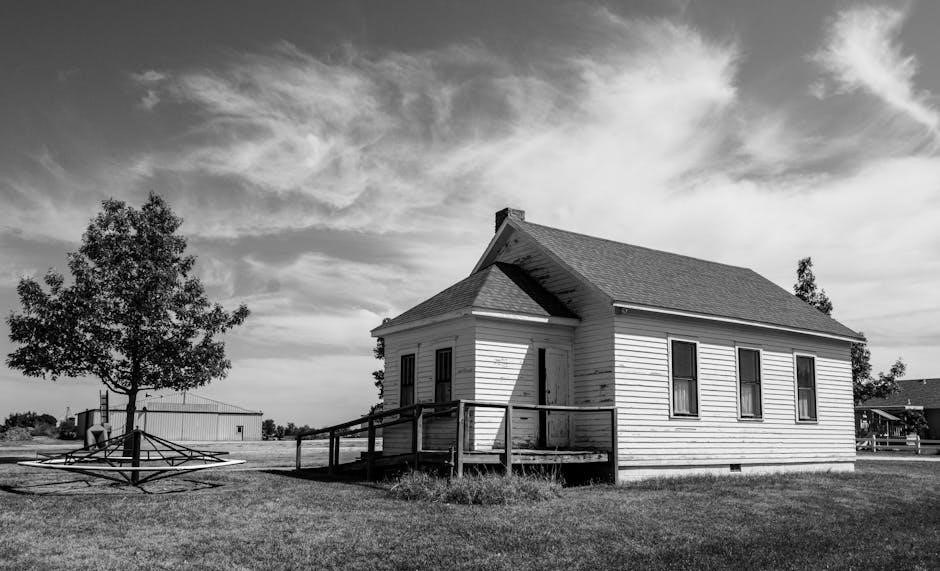Discover simple church building plans with free resources from Life.Church, offering cohesive designs for multiple campuses; These plans provide scalability, flexibility, and essential details for construction and design.
Design Considerations
Focus on functionality and aesthetics with simple church building plans. Consider open floor plans for flexibility, exterior appeal, and interior versatility to meet community needs effectively.

Exterior Design
Simple church building plans often emphasize clean lines and minimalist aesthetics for a welcoming yet unpretentious appearance. Exterior designs frequently incorporate sloping roofs and natural materials like wood or brick to create a timeless and approachable look. Many plans prioritize cost-effectiveness by using straightforward construction methods, such as gabled roofs, which are both functional and visually appealing. The exterior should also reflect the church’s purpose, blending seamlessly into its surroundings while maintaining a sense of community focus. Proper lighting and landscaping can enhance the building’s curb appeal without complicating the design. These elements ensure the church remains a beacon of simplicity and accessibility, aligning with its mission to serve the congregation and community effectively.

Interior Design
Simple church building plans focus on creating a functional and welcoming interior space that supports both worship and community activities. Open floor plans are often utilized to maximize flexibility, allowing for adaptable seating arrangements and multipurpose use. The design typically features minimalist aesthetics, with clean lines and uncluttered spaces to foster a sense of calm and focus. Natural lighting is prioritized through large windows, while acoustics are carefully considered to ensure optimal sound quality for sermons and music. Interior materials are often chosen for their durability and cost-effectiveness, such as wood or laminate finishes. Storage solutions are integrated seamlessly to maintain a tidy environment. These designs ensure the interior is both practical and inspiring, catering to the needs of the congregation while remaining true to the principles of simplicity and accessibility.

Flexibility and Scalability
Simple church building plans emphasize flexibility and scalability to accommodate growing congregations and evolving needs. Open floor plans allow for easy reconfiguration, enabling spaces to serve multiple purposes such as worship, community events, or classrooms. Modular designs are often incorporated, enabling churches to expand or modify layouts without significant reconstruction. This approach ensures that the building can adapt to future growth while maintaining functionality. Cost-effective materials and strategic layouts further enhance scalability, making it easier to add extensions or upgrade facilities as required. By prioritizing versatility, these plans provide a practical foundation for churches to thrive, whether they are starting small or planning for future expansion. This ensures the building remains a valuable asset for years to come, supporting both current and future ministries.

Floor Plans
Explore simple church building plans with detailed layouts, including ground floor and second floor designs. These plans feature activity centers and essential spaces for worship and community gatherings, available as PDF templates.
Ground Floor Layout
The ground floor layout in simple church building plans typically includes a spacious sanctuary, a welcoming foyer, classrooms, and essential amenities. Open spaces are designed for flexibility, allowing easy navigation and multi-purpose use. The sanctuary often features a central stage or altar, with seating arranged to accommodate congregations of various sizes. Classrooms and meeting rooms are strategically placed for accessibility, while restrooms and storage areas are conveniently located. Many plans emphasize natural lighting and acoustically friendly designs to enhance worship experiences. These layouts are often available as downloadable PDF templates, providing a clear blueprint for construction and design. Life.Church and similar resources offer these plans to help churches create functional and inspiring spaces for their communities.
Second Floor Plan
The second floor plan in simple church building designs often includes administrative offices, youth centers, and additional storage spaces. This level is typically designed to support the main worship and community areas on the ground floor. Offices for pastors and staff are usually equipped with basic amenities, while youth centers may feature open spaces for activities and smaller rooms for group meetings. Storage areas are strategically located to keep essential supplies organized without interfering with daily operations. Some plans also incorporate multi-purpose rooms that can be adapted for various functions, ensuring flexibility. These layouts are often included in downloadable PDF templates, providing a comprehensive guide for constructing a functional and efficient second floor. Life.Church and similar resources offer these plans to streamline the design process for churches of all sizes.
Activity Centers
Activity centers are essential spaces in church designs, fostering community engagement and diverse gatherings. These areas are often designed with open floor plans to accommodate various activities, such as youth programs, workshops, and social events. Multi-purpose rooms are a key feature, allowing for flexibility in hosting different functions. Storage solutions, like built-in shelves or cabinets, are incorporated to keep supplies organized. Some plans include smaller breakout rooms for focused discussions or Bible studies. The layout ensures easy access to restrooms and common areas, promoting a seamless flow of movement. These centers are often highlighted in downloadable PDF templates, providing churches with practical and adaptable designs. By integrating activity centers, churches can create vibrant spaces that support their mission and community needs effectively.

Construction Tips
Effective construction begins with selecting durable, cost-efficient materials. Hiring skilled labor ensures quality craftsmanship. Proper time management and adherence to building codes are crucial for successful project completion.
Material Selection
Selecting the right materials is crucial for a simple church building. Opt for durable, cost-effective options like steel frames, brick exteriors, and energy-efficient roofing. Consider eco-friendly alternatives such as reclaimed wood or sustainable insulation to reduce environmental impact. Ensure materials align with the building’s aesthetic and functional needs. For instance, open floor plans may benefit from lightweight, versatile materials. Life.Church resources offer detailed guides on material choices, emphasizing scalability and budget-friendly options. Proper material selection not only enhances the structure’s longevity but also supports energy efficiency and acoustic performance, essential for worship spaces. Always verify local building codes and consult experts to ensure compliance and optimal results.

Labor and Expertise
Constructing a simple church building requires skilled labor and expertise to ensure quality and safety. Hire experienced contractors familiar with religious structures to handle complex tasks like electrical systems and plumbing. Consider involving local volunteers for non-specialized work to foster community engagement. Life.Church resources provide guides for managing labor effectively, emphasizing clear communication and project timelines. Ensure all workers adhere to safety protocols and building codes. Expertise in areas like acoustics and AV systems is crucial for worship spaces. Budget appropriately for labor costs, balancing professional services with volunteer contributions. Proper planning and skilled execution will result in a functional, inspiring space that meets the congregation’s needs while staying within budget and timeline constraints.
Time Management
Effective time management is crucial for completing a simple church building project efficiently. Create a detailed timeline, breaking the project into phases like planning, construction, and finishing. Allocate sufficient time for each stage, considering potential delays. Utilize resources from Life.Church to streamline processes and avoid unnecessary setbacks. Regularly monitor progress and adjust schedules as needed. Ensure all stakeholders are informed and aligned with deadlines. Proper planning and adherence to timelines will help complete the project on time and within budget. Consider hiring professionals who can work efficiently while maintaining quality. By prioritizing tasks and managing time wisely, the church can ensure a smooth construction process and a timely completion of the building. This approach fosters community trust and excitement for the new space. Stay organized and proactive to meet all project milestones successfully.
Resources and Downloads
Access free church building plans and PDF templates from Life.Church, offering cohesive designs for various campuses. Download schematics for First Baptist Church and St Ediths Church layouts.
Life.Church Resources
Life.Church provides free church building plans and schematics, designed to create a cohesive feel across multiple campuses. These resources include detailed floor plans and architectural drawings, offering scalability and flexibility for churches of various sizes. The plans emphasize simplicity and functionality, making them ideal for both small and large congregations. Life.Church also shares PDF templates for easy customization, ensuring that churches can adapt the designs to meet their specific needs. By offering these resources, Life.Church aims to support churches in constructing spaces that foster community and worship. The designs are practical, sustainable, and aligned with modern architectural trends, making them a valuable resource for any church planning or expansion project.
PDF Templates
Download free PDF templates for church building plans, offering scalable and customizable designs. These templates provide detailed layouts, including floor plans and architectural schematics, suitable for churches of all sizes. The PDFs are designed to be user-friendly, allowing easy modification to fit specific needs. They include essential elements like seating arrangements, stage layouts, and utility rooms. Many templates are available online, catering to both small and large congregations. These resources are ideal for churches looking to construct or renovate their spaces efficiently. The templates ensure consistency and coherence in design, making the planning process streamlined and stress-free. By utilizing these PDF templates, churches can save time and resources while creating functional and aesthetically pleasing worship spaces.
Cost Estimation
Access cost estimation resources for church projects, including budgeting tips and material cost guides. These tools help plan expenses efficiently, ensuring projects stay within budget.
Budgeting Tips
Effective budgeting is crucial for managing church building costs. Start by prioritizing essential features and allocating resources wisely. Consider using cost-effective materials and scalable designs to reduce expenses. Life.Church offers free resources, including budget templates and construction guides, to help plan expenses efficiently. Additionally, explore options for phased construction, allowing your church to expand as funds become available. Regularly review and adjust your budget to accommodate unexpected costs. Utilize volunteer labor and community contributions to minimize labor expenses; Finally, consult with experts to ensure accurate cost estimates and avoid financial overruns. By following these tips, your church can achieve its building goals without exceeding its budget.
Cost-Effective Materials

Choosing cost-effective materials is essential for building a church within budget. Opt for durable, affordable options like steel framing, prefab panels, and energy-efficient roofing. These materials reduce construction costs while ensuring longevity. Consider using locally sourced or recycled materials to lower expenses further. Simple designs often require fewer resources, making them more economical. Life.Church resources offer guidance on selecting materials that balance affordability and quality. Additionally, explore options like modular construction or repurposing existing structures to save on costs. Prioritize materials that are easy to install, reducing labor expenses. By focusing on practical, sustainable choices, your church can achieve a functional and aesthetically pleasing space without overspending. This approach ensures your building project remains financially viable while meeting the needs of your congregation.

Sustainability
Sustainability focuses on eco-friendly materials and energy efficiency to create environmentally responsible church buildings. Simple designs often incorporate natural lighting and renewable resources, reducing long-term costs.
Energy Efficiency
Energy efficiency is a critical aspect of sustainable church building design. Simple church plans often incorporate natural lighting and insulation to minimize energy consumption. Strategic window placement and skylights reduce the need for artificial lighting during the day. Additionally, energy-efficient HVAC systems and LED lighting are commonly recommended to lower utility costs. Renewable energy sources, such as solar panels, can be integrated into designs to further reduce reliance on non-renewable energy. These practices not only benefit the environment but also help churches save on long-term operational expenses. By prioritizing energy efficiency, churches can create spaces that are both environmentally responsible and cost-effective, aligning with modern sustainability goals while maintaining functional and spiritual needs.
Eco-Friendly Materials
Eco-friendly materials are essential for sustainable church building designs. Simple church plans often recommend using reclaimed wood, bamboo, and recycled metals to minimize environmental impact. Low-VOC paints and sustainable roofing materials, such as metal or recycled rubber, are also popular choices. These materials not only reduce construction waste but also align with spiritual values of stewardship. Energy-efficient insulation made from natural fibers like wool or cotton further enhances sustainability. By incorporating eco-friendly materials, churches can create durable, environmentally responsible spaces that support long-term cost savings and promote a healthier indoor environment. These practices reflect a commitment to preserving natural resources while maintaining functional and aesthetic appeal.
Safety and Compliance
Ensure safety and compliance by adhering to local building codes and installing necessary firefighting equipment. Clear emergency exits and accessible pathways are crucial for occupant safety and legal requirements.
Building Codes
Adhering to local building codes is essential for ensuring the safety and legality of your church structure. These codes outline specific requirements for construction, including fire safety, accessibility, and structural integrity. Life.Church resources provide detailed plans that often align with standard building codes, simplifying compliance. Key considerations include proper exit routes, emergency lighting, and fire-resistant materials. Additionally, accessibility standards must be met to ensure the building is usable by all individuals. Regular inspections and certifications are necessary to verify compliance. By following these guidelines, you can create a safe and legally sound worship space. Downloadable PDF templates and schematics from reliable sources can further assist in meeting these requirements effectively. Always consult local authorities to ensure all regulations are satisfied.
Emergency Exits
Ensuring proper emergency exits is critical for church building safety. Plans must include clearly marked exit routes, adequate signage, and sufficient lighting to guide occupants during evacuations. Building codes typically require multiple exits based on occupancy levels and building size. These exits must be easily accessible, free from obstructions, and visible at all times. Fire safety regulations often mandate the installation of emergency lighting and illuminated exit signs. Additionally, regular inspections are necessary to ensure compliance and functionality. Life.Church resources and downloadable PDF templates often include detailed exit strategies to meet these requirements. Proper planning ensures a safe environment for worshippers and adheres to legal standards. Always consult local fire safety guidelines to guarantee compliance.

Technology Integration
Modern church designs incorporate advanced AV systems and acoustics for enhanced worship experiences. Life.Church resources provide detailed plans for seamless technology integration, ensuring clarity and connectivity in worship spaces.
Acoustics
Acoustics play a crucial role in church design, ensuring clear sound distribution for sermons and music. Simple church building plans often include sound-absorbing materials and strategic seating layouts to minimize echo and enhance audio clarity. Open floor plans, common in modern designs, require careful placement of speakers and sound systems. Life.Church resources provide detailed schematics for optimizing acoustics, balancing aesthetics with functionality. These plans cater to various church sizes, from small gatherings to large congregations, ensuring every attendee enjoys an immersive worship experience. Proper acoustic design not only improves sound quality but also creates a more engaging environment for prayer and community connection.
AV Systems
Integrating AV systems into church designs is essential for enhancing worship experiences. Simple church building plans often include layouts that accommodate high-quality audio and video equipment. Life.Church resources provide detailed schematics for installing speakers, screens, and control panels, ensuring seamless integration. Open floor plans allow for optimal speaker placement, while wired infrastructure supports reliable connectivity. These designs emphasize flexibility, enabling churches to adapt AV systems to their specific needs. Whether for live sermons or multimedia presentations, the plans ensure clear sound distribution and visual clarity. By incorporating modern technology, churches can create engaging environments that support their mission and community engagement. Properly designed AV systems enhance the overall worship experience, making them a vital component of contemporary church architecture.
Simple church building plans offer a practical and efficient way to design worship spaces that meet the needs of congregations. By focusing on essential elements like open layouts, scalable designs, and cost-effective materials, these plans provide a foundation for constructing functional and inspiring churches. Resources from Life;Church and other organizations make it easier for communities to access proven designs, ensuring consistency and cohesion across campuses. Whether for small, medium, or large congregations, these plans emphasize flexibility and adaptability, allowing churches to grow and evolve. The integration of modern technology, such as AV systems, further enhances the worship experience. Ultimately, simple church building plans empower churches to create spaces that foster connection, reflection, and community engagement, aligning with their mission and values.
